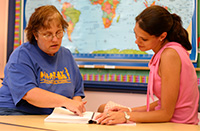Preliminary Activities for Pals Reading and Mathematics
What characteristics might the teachers at Washington Uncomplicated await for in a reading approach?
Folio one: Overview of PALS
 As they search for an approach capable of both meeting the needs of diverse learners and strengthening the didactics in the full general instruction classroom (i.east., Tier 1 teaching), the kindergarten and showtime-course teachers at Washington Elementary discover Peer Assisted Learning Strategies for reading (PALS-R or PALS). PALS, modeled later on ClassWide Peer Tutoring (CWPT), is an arroyo to education children of import reading skills. It complements the existing reading curriculum by providing enquiry-validated learning strategies through peer-mediated educational activity (i.e., peer pairing, peer tutoring). In the PALS approach, teachers pair a high-performing reader with a low-performing one in lodge to complete activities designed to promote the development of reading skills. PALS also incorporates:
As they search for an approach capable of both meeting the needs of diverse learners and strengthening the didactics in the full general instruction classroom (i.east., Tier 1 teaching), the kindergarten and showtime-course teachers at Washington Elementary discover Peer Assisted Learning Strategies for reading (PALS-R or PALS). PALS, modeled later on ClassWide Peer Tutoring (CWPT), is an arroyo to education children of import reading skills. It complements the existing reading curriculum by providing enquiry-validated learning strategies through peer-mediated educational activity (i.e., peer pairing, peer tutoring). In the PALS approach, teachers pair a high-performing reader with a low-performing one in lodge to complete activities designed to promote the development of reading skills. PALS also incorporates:
x
ClassWide Peer Tutoring
Instructional program in which pairs of students have turns acting every bit the tutor; originally designed to accost developmental goals among students, with or without disabilities, from low socioeconomic backgrounds.
- Highly structured activities that take been demonstrated to improve students' learning
- Reciprocal peer tutoring (i.e., during every session, each student in the pair serves equally a Bus and as a Reader)
ten
reciprocal peer tutoring
A method of education in which students have turns acting as tutor. In PALS, the educatee in the role of tutor is referred to as the Coach, while the pupil being tutored is referred to as the Reader. Typically, the Coach provides constructive feedback (i.east., cosmetic feedback) to the Reader on his or her operation.
- Frequent verbal interaction and corrective feedback between the Coach and Reader
- The employ of scripted prompts
PALS combines peer-mediated instruction with effective reading activities. Mind at present every bit Lynn Fuchs discusses the peer mediation component and Doug Fuchs highlights some of the reading activities and the skills they address.

Lynn Fuchs, PhD
Nicholas Hobbs Endowed Chair
in Special Education and Human Development
Vanderbilt University, Nashville, TN
(fourth dimension: 1:17)
View Transcript

Doug Fuchs, PhD
Nicholas Hobbs Endowed Chair
in Special Education and Human Development
Vanderbilt Academy, Nashville, TN
(time: 1:nineteen)
View Transcript
Transcript: Lynn Fuchs, PhD
Nosotros realized early in our work that we needed to find methods that teachers could contain easily. And peer arbitration—where all the students in the class are paired to do activities that the teacher orchestrates with the classroom—is one way that teachers tin feasibly contain innovative methods to their fourth dimension and their retraining in a depression-cost kind of mode. Clearly the most unique component of PALS, specially at kindergarten and first form, is that immature children are working with each other. They're conducting activities with each other, providing feedback to each other when errors are fabricated, and so that children can become ameliorate at the activities. So the peer mediation is the nigh unique feature of PALS. I think nigh people assumed that children couldn't exist very effective tutors to their classroom peers at the ages of five and six, but we accept constitute that, in fact, they can be very effective in working productively and constructively with each other, and, in fact, kids' reading and math outcomes tin be substantially enhanced when children work on very structured activities with each other.
Transcript: Doug Fuchs, PhD
There'southward really two aspects to PALS. One is the organizational part of it that brings kids together to piece of work in a cooperative, supportive way. The other part—the more than substantive office—are the activities. I'll give you an example. In early reading, the activities that children are trained to engage in require them to practise phonological awareness—that is, to become very sensitive to the sounds in words and the fact that sounds in words are represented by the letters in our alphabet. A 2d activity would exist decoding activities that requite kids lots of opportunities to alloy and segment words. Another action is fluency building, where kids practise reading, quickly and accurately, connected text. And a fourth activity is comprehension. So from phonological awareness through beginning decoding, fluency building, comprehension, these are sub-areas of early reading that are known by many, many people to be necessary edifice blocks to get to the point where you've got a capable reader.
For Your Information
A major component of the response to intervention (RTI) approach is high-quality instruction. In RTI, the instruction provided in the general education classroom is referred to as Tier i instruction. Research on PALS indicates that near of the students who engage in this strategy demonstrate improved reading performance. Every bit a upshot, PALS is now promoted every bit a promising Tier i instructional strategy, and in some schools is also being implemented as a Tier two intervention.
Though PALS was originally developed for use with students in grades two through six, information technology was later expanded to include versions for kindergarten and first-form students. Because Washington Unproblematic is interested in approaches appropriate for younger students, this module highlights PALS for kindergarten and showtime course. If y'all would similar to learn more about PALS for other grade levels, we encourage you to take a wait at these IRIS Modules:
- PALS: A Reading Strategy for Grades two–6
- PALS: A Reading Strategy for High Schoolhouse
Source: https://iris.peabody.vanderbilt.edu/module/palsk1/cresource/q1/p01/
0 Response to "Preliminary Activities for Pals Reading and Mathematics"
Post a Comment